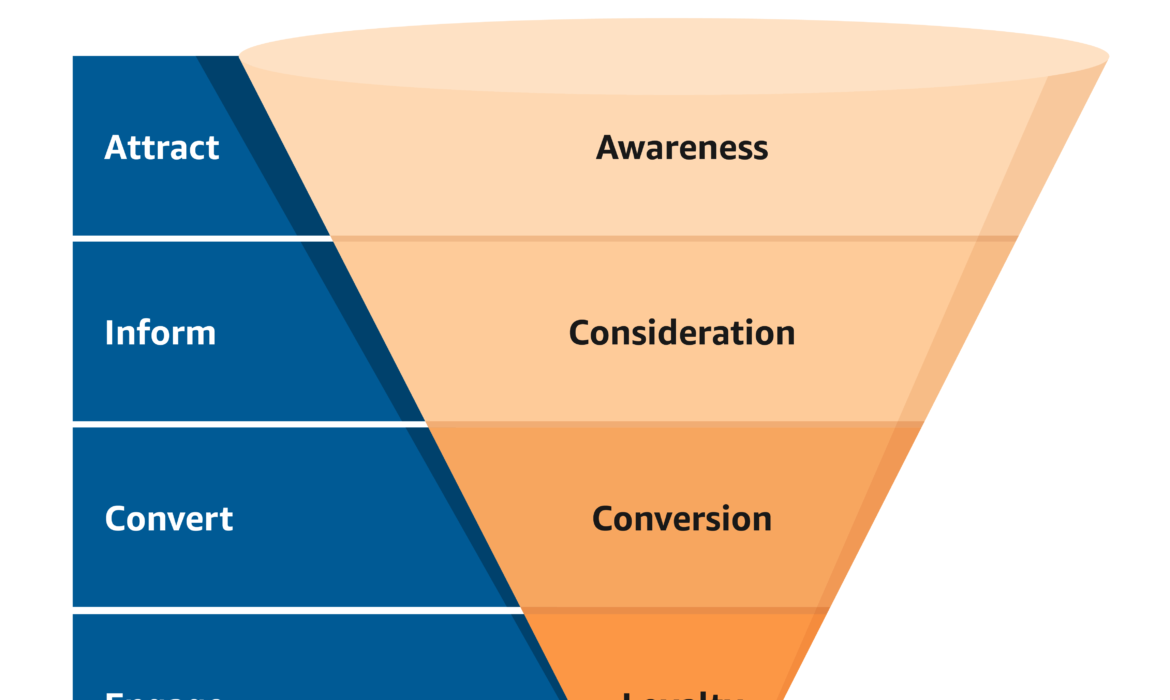081-4797-7173
“The key to successful marketing funnel optimization is understanding your customers and tailoring your approach to meet their needs.”
Marketing funnels are relatively simple concepts, but optimizing them for your organization can feel like a challenge.
What is Marketing Funnels
This is also called sales funnel or conversion funnel. A marketing funnel is a visual representation of the process through which people go from first learning about a brand to becoming loyal customers. It can also be said to represents a prospective customer’s stages along the buyer’s journey. From their first interaction with your brand to making a purchase.
A marketing funnel provides a structured visual that helps you understand and engage with customers. A marketing funnel is a conceptual tool that businesses use during the sales process to convert potential sales leads into actual sales, increase sales numbers, and improve their overall ROI (return on investment) and other core digital marketing metrics.
To best understand the concept of a “ marketing funnel,” it’s helpful to picture an actual funnel. When pouring a liquid into a funnel, the liquid first goes into a wide-open top and is then concentrated down into a much smaller, focused point.
Marketing funnels operate in much the same way. The large, open end of your sales funnel is the first engagement that potential customers have with your business. The goal of this approach is to guide the potential customer through the full funnel with a targeted sales approach, fine-tuning the stream of customer engagement until you arrive at a successful sale. Ideally, a sales funnel helps convert interest in your company into loyal paying customers.
Marketing funnel is wide at the top but become narrow at the bottom because it is not all potential customers that heard about you products or services actually buy.
Stages of marketing funnel
There are different stages of marketing funnel but we are going to be taking about four which are
- Awareness stage: This is when a potential customer encounter your brand for the first time.
- Consideration stage: this is when a potential customer is getting to know about your brand. During this stage the goal is to increase the chances that potential customers will eventually make a purchase .
- Conversion stage: This is know as the decision or purchase stage, this is when someone makes a purchase and become a customer. The goal of this stage is to turn potential customer to buyer
- Loyalty stage: customer loyalty depend on the quality and value of your products. Building loyalty is creating great customer experience during and after purchase.
The first two stages are refers to as the top of the funnel while the last two stages are refers to as the bottom of the funnel.
Importance of Marketing Funnels
- Marketing funnels help to convert leads into sales, increase revenue and improve marketing ROI.
- Marketing funnels outline marketing strategies and map interactions across the customer lifecycle.
- Building a marketing funnel allows you to influence buying decisions without active intervention. But you can’t leverage the benefits of a sales funnel without optimizing it.
What is Marketing Funnel Optimization
“By analyzing and optimizing each stage of your sales funnel, you can identify areas for improvement and maximize your conversion rates.”
Marketing Funnel Optimization refers to the process of improving and refining each stage of a marketing funnel to maximize the effectiveness of converting leads into customers. This involves identifying and fixing bottlenecks, improving user experience, and utilizing data-driven strategies to increase conversions.
Marketing funnel optimization means making more people buy your products by understanding what they want and what problems they have. You can do this by testing simple things to see what works best.
It can also be defines as the process of refining and enhancing various stages of the sales journey to increase the likelihood of conversion.
Understanding client needs and pain points is crucial for effective optimization.
Goals Of The Marketing Funnel Optimization
To achieve successful marketing funnel optimization, the primary goals include intensifying the efficiency of your marketing system and minimizing Customer Acquisition Cost (CAC).
The ultimate goal is to increase revenue by driving the incredible number of prospects to become paying customers.
Statistics and Insights of Marketing Funnel
Let’s explore some key statistics and insights related to sales funnels:
Conversion Rates and Revenue
On average, 70-95% of revenue comes from upsells and renewals in businesses that use them.
30% of businesses surveyed consider a conversion rate between 3.1% and 5% as a good range for marketing funnel conversion rates.
96% of visitors are not ready to buy initially, while 95% of buyers choose a business with sufficient content.
General Sales Funnel Statistics
Approximately 570,000 websites employ at least one technology for building sales funnels.
The typical conversion rate for landing pages stands at 2.35%.
Web pages featuring a single call-to-action observe an average conversion rate of 13.50%1.
Lead Nurturing and Conversion:
69% of marketers indicate that transforming contacts or leads into customers is their primary goal.
Business Sales Funnel Statistics:
Companies simplifying the buying process have a 62% higher chance of securing a quality sale.
Benefits Of Optimizing your Marketing funnel
- Creating more loyal customers once you understand their wants and needs.
- Pushing more prospects through the marketing funnel.
- Identifying the best marketing strategy to catch customers at the awareness stage.
- Enjoying an edge over your competitors because you are constantly refining your sales funnel.
10 Ways to Optimize Your Marketing Funnel
1. Know your Target Audience
To maximize conversions, you need to target those who are interested in purchasing your products, so understanding your audience is essential. If you are targeting the wrong type of customer, your sales funnel will be ineffective, costing you time, money and resources, and delivering very little in the way of results.
You can’t sell to an audience without understanding who they are and what they like. The best way to identify who you should target is with a buyer persona a research-based semi-fictional representation of your ideal customer.
Buyer personas give you insights into who your buyers are, how they think, and what motivates them. They can help you target prospects at the top of the funnel, minimize drop-offs at the Awareness stage, and improve your sales funnel conversion rate.
To build buyer persona. Here’s what you should focus on: age, location, interests, occupation, technology, social media preferences etc. Armed with this data, you can create an outline of your ideal customer.
The awareness stage is at the very beginning of the maeketing funnel. You need to capture as many leads as possible in order to keep your reach wide. If you target too small an audience or a niche audience, you risk losing out on customers that may have converted at the end of the sales funnel.
When you understand who you are targeting, you can then decide how you will target them on social media, through marketing campaigns, sales prospecting, etc.
2. Optimize your Landing pages
The landing page is where potential customers learn about your products and brand. Whether it’s through an ad, blog post, or webinar, when they reach your landing page, it should communicate what your brand represents, what it offers, and how it solves their problems.
It’s essential to maintain a consistent brand voice and message across all channels. After all, we’re still in the Awareness stage of the sales funnel.
This is still in the early stages of your sales funnel as it’s one of the first interactions a prospect has with your business, especially if they find you via a Google search. Once a customer has passed the awareness stage of the sales funnel by finding your business, they filter through to the interest stage. This is where they head to your website to see whether you’re offering something they need.
Say the customer is looking for a “video on how to use new software.” When the search results come up in Google, they will usually be directed to a landing page.
Ensure your content is engaging and interesting, and include persuasive language to entice the reader. If a potential customer clicks away from your landing page too soon, it can affect your bounce rate.
3. Create Engaging Content
Building a strong identity is a must. To optimize your marketing funnel, you need to build relationships with your customers both old and new. This can be done through brand tone of voice and image and overall brand identity.
Engaging content will attract customers at the very start of the sales funnel. These prospects will hopefully trickle down the funnel and convert into paying customers.
When a customer feels connected to your brand, whether it’s your products or your philosophy, they are more likely to engage with it. This should be part of your brand communication strategy.
Content on social media should encourage customers to like, comment, share and even convert into paying customers. The content on your website should be just as engaging, sharing the same tone and brand persona that’s featured on the social site.
4. Optimize Your CTAs.
Every page and piece of content on your website needs a clear purpose and a call to action (CTA) that encourages prospects to move to the next stage of the funnel. CTAs can be used at every stage of the sales funnel to motivate customers to filter through.
You can use phrases such as “Sign up for a free trial” or “Get the free ebook” in the Awareness stage to generate leads and customer inquiries. Similarly, you can use words such as “Jump on a call to learn more” or “Reach out to our team for more information” to engage with prospects in the interest stage.
CTAs such as “Limited time offer” or “Exclusive discount” work great in the consideration and conversation stages. The key is to use your CTAs multiple times on every landing page and position them in a way that captures your customers’ attention.
5. Be Active on Social Media
Where is your traffic coming from? If you create engaging content on your social channels, the majority of people heading to your site may be seeing you through social media. So you must stay functional on your social channels.
Social media is remarkable because it can cover every stage of the sales funnel. You can: Build brand awareness through engaging posts, Get consideration competitions, direct followers to your website, and even sell directly from the “Shop” feature in the app.
It could be claimed that social media is mainly part of the awareness stage of the sales funnel, simply because it aims to attract followers and therefore, business awareness. But don’t underestimate the ability to sell at this stage.
Engage a social media manager and feed them exciting content. Posting on Facebook, LinkedIn, Instagram and TikTok will give your company amazing exposure.
6. Create Goals in Google Analytics
Creating goals can help you visualize your sales funnel and give you a target to work toward. Doing this in Google Analytics will help you track your goals methodically. It’s at this point you transition from the awareness stage of the marketing funnel to the consideration stage. Now that you know customers have made it to your website, you need to establish what keeps them there.
The data gathered from your e-commerce website will allow you to see how users are interacting with your product/service. This includes how long they spend on your site and at what point they either abandon their cart or make a purchase.
Ask yourself questions when looking through the data, such as:
Does changing the price further down the sales path help to increase conversions?
What is the average bounce rate on the site?
Would adding informative pop-ups improve or decrease conversions?
7. Capture Leads
Once you’ve impressed your customers with targeted content and compelling CTAs, it’s time to funnel them into the consideration stage. When customers share their information with your business, they’re expressing an interest in your product or service.
In doing so, they move from the Awareness stage to the consideration stage. The best way to make this happen is using a lead generation form that captures their contact information and allows the community to start a conversation.
Make sure you set expectations upfront during signup and offer something valuable in return. Prospects are unlikely to share their contact information without it. Access to a discount coupon or free ebook on signage tended to deliver value.
8. Use Email Marketing To Nurture Leads
Capturing your customers’ attention alone isn’t enough. You also need to increase interest in your products and move them to the next marketing funnel stage. An easy way to do that is with email marketing.
Contrary to popular belief, email continues to be one of the best-performing sales channels. Research by HubSpot found that 64% of small businesses effectively use email marketing to reach customers.
9. Utilize Reviews and Testimonials
What better way to receive praise than from a happy customer? Even more so when that customer tells their friends and family about your business. This creates trust for your brand and builds loyalty, which is an important element of the marketing funnel. It also helps you build relationships with your customers. This boosts the chances of repeat purchases.
If a customer has come far enough to look at reviews and testimonials of your brand, they have made it to the conversation stage of the sales funnel. They are captivated enough to look at what others think of your product and want to see whether it’s worth making a purchase.
It’s easy to collect honest reviews from customers with sites such as Google offering customers the chance to share their feedback about your business with the world. You can also create your surveys to gather additional feedback.
Sometimes you can integrate these reviews into your website and showcase them next to your products. This enables you to stand out from your competitors and gives customers a good idea of what quality of service they will be receiving if they order from you.
10. Reduce Friction at the Conversion Stage
Nurturing prospects and establishing trust leads them into the Action stage. But your job isn’t done yet. Even your best leads can fall out at this point if you’re not careful.
A recent quantitative study by the Baymard Institute revealed that 69.82% of online shoppers abandon their purchase due to reasons such as High shipping, tax, or other fees, Missing guest checkout option, Slow delivery and Lack of trust. Each reason represents a friction point at the conversion stage and an opportunity to optimize your marketing funnel. Don’t know how to do it?
Here are four helpful tips to reduce checkout friction:
- Don’t force signup during checkout; leave that for the “Thank you” page.
- Implement a one-page checkout process to minimize steps.
- Offer free delivery by including the delivery into your product margin.
- Include trust signals such as payment gateway logos and security trust badges in your site footer and on the checkout page.
In conclusion
Conversion goals at each stage of the marketing funnel vary tremendously. Marketing funnels aren’t meant to convert leads in the first interaction. So make sure you aren’t forcing users to act. Instead, optimize your sales funnel to help them flow through it organically.
Focus on small yet consistent micro-conversions at each stage of the funnel and modify your creatives to target changing customer needs in each step of the buying journey.
“Building trust is essential for sales funnel optimization. By providing valuable content, testimonials, and social proof, you can establish credibility and gain the trust of your prospects, leading to higher conversion rates.”






